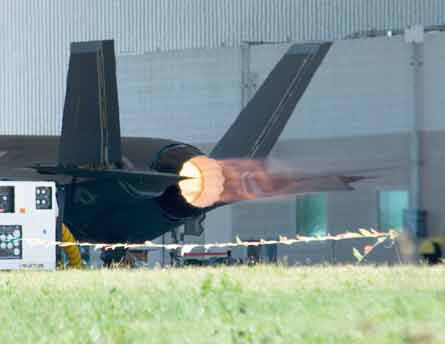Initial ground runs successful but first flight put back following system failure
Lockheed Martin has completed initial engine ground runs in the F-35 Joint Strike Fighter, but the first flight continues to slip and the production ramp-up looks certain to be slowed, driving up costs.
The Pratt & Whitney F135 was started for the first time in the aircraft on 15 September, culminating in a full-afterburner test on 18 September in which the engine generated almost 40,000lb (178kN) of thrust. The first aircraft, AA-1, has been returned to the hangar at Fort Worth, Texas for installation of the remaining flight-qualified components, and a first flight is now expected between mid-November and mid-December.
|
|---|
The P&W F135 started first time in tests on 15 September at Fort Worth |
First flight was originally planned for late August, but was delayed when the F-35’s Honeywell-developed integrated power pack (IPP) failed qualification testing. The IPP combines the auxiliary and emergency power units and environmental control system to save weight, and is required to start the engine and power the aircraft.
The IPP is a small gas turbine that provides power to the engine-mounted starter/generator to “motor” the F135 to its starting speed. The engine then accelerates to idle speed, and the system transitions from operating as a motor to operating as a generator, driving aircraft systems including power-by-wire flight controls.
“The IPP started first time, and every time, and generated the power needed to start the main engine, which was critical,” says Doug Pearson, vice-president of the F-35 integrated test force. “The main engine was similar – the first time it was commanded, it started.” The IPP was started 20 times, motoring or starting the engine 12 times.
Initial ground runs were “the major domino leading up to taxi and flight tests”, says Tom Burbage, executive vice-president and general manager, F-35 programme integration. The time required to remove and replace parts with flight-qualified components will pace the tests. “We will fly when the aircraft is ready,” says Pearson.
The ground runs allowed Lockheed to test the F-35’s flight-test instrumentation, telemetry and control room. “The system operated first time, with only a few interface issues,” says Pearson.
Lockheed had hoped to fly the F-35 before Congress completed its mark-up of the fiscal year 2007 defence budget, but with final House-Senate conferences under way it looks certain the first two low-rate initial production batches will be trimmed back to give more time for flight testing, pushing up the cost of early aircraft.
| Don’t slow F-35 production US Congress is concerned there is too much overlap between development and production of the F-35, but Lockheed Martin argues that “the risk is controlled”. Instead, the manufacturer says, slowing the production ramp-up would disrupt the supply chain and drive up the cost of early aircraft, jeopardising the affordability on which the Joint Strike Fighter (JSF) programme is predicated. To support its argument, Lockheed says the software load with which the F-35 will fly has already run in the aircraft “and we have not had to change it”. Software is being developed in phases and the initial Block 0.1 is about 70% complete, slightly behind schedule. Block 0.1 “is almost all of the vehicle systems software” – and about 30% of the total – and will allow handling qualities and performance testing. The first mission-system software, Block 0.5, is just over 40% complete, Lockheed says, and work has already started on Blocks 1, 2 and 3, which will take the F-35 to its planned mission capability. The “Catbird” avionics flying testbed, a modified Boeing 737, will be delivered to Fort Worth, Texas by year-end for installation of the JSF sensors and systems and will be used to test the “fully integrated and fused software” before it flies in the F-35. |
|---|
Source: Flight International

















